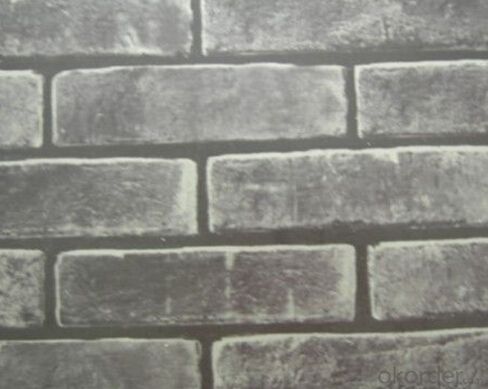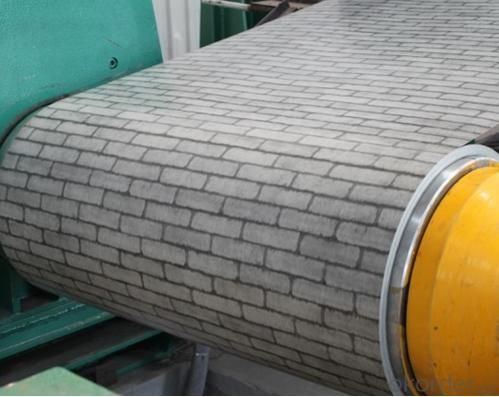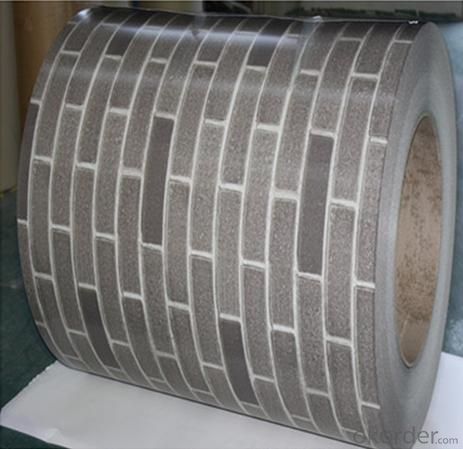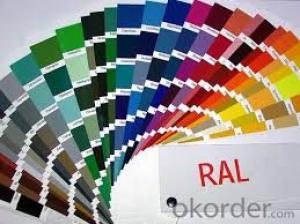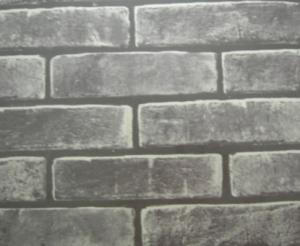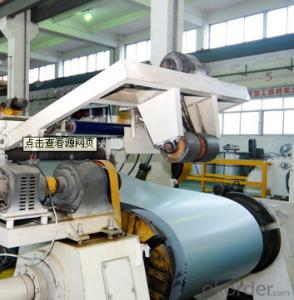Print Prepainted Galvanized Steel Coil Brick Pattern
- Loading Port:
- Shanghai
- Payment Terms:
- TT OR LC
- Min Order Qty:
- 25 m.t.
- Supply Capability:
- 5000 m.t./month
OKorder Service Pledge
OKorder Financial Service
You Might Also Like
1.Structure of Print Prepainted Galvanized Steel Coil Brick Pattern:
With GI as base metal,after pretreatmet (degrease and chemical treatment) and liquid dope with several Layers of color,then after firing and cooling,finally the plate steel is called pre-painted galvanized steel ( PPGI) .Pre-painted galvanized steel is good capable of decoration ,molding,corrosion resistance
2.Main Features of Print Prepainted Galvanized Steel Coil Brick Pattern:
• Excellent process capability
• Smooth and flat surface
• Workability, durability
• Excellent heat resistance performance
• High strength
• Good formability
• Good visual effect
3.Print Prepainted Galvanized Steel Coil Brick Pattern Images
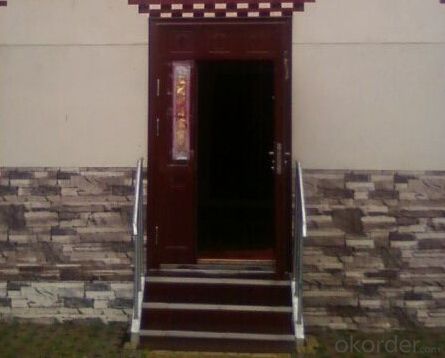
4.Print Prepainted Galvanized Steel Coil Brick Pattern Specification:
Standard:ASTM, GB,JIS,JIS G3302 ASTM 755 EN10169
Grade: DX51D CGCC CS
Thickness: 0.13mm~3.0mm,
Width: 1250,600-1250mm
Coil weight:3-12 MT
Coil ID:508/610mm
Chemical composition:
C | Si | Mn | Cr | Ni | P | S |
0.150 | 0.476 | 11.231 | 12.50 | 0.900 | 0.039 | 0.010
|
5.FAQ of Print Prepainted Galvanized Steel Coil Brick Pattern:
We have organized several common questions for our clients,may help you sincerely:
1.How do you control your quality
We have established the international advanced quality management system,every link from raw material to final product we have strict quality test;We resolutely put an end to unqualified products flowing into the market. At the same time, we will provide necessary follow-up service assurance.
2.How long we will receive the goods ?
After receiving your deposit or workable lc ,our normal shipment date is 15-20days,and it takes around 28 days to reach your port of destination. But is up to different destination
3. What is your MOQ?
Normally our MOQ is 25mt per size ,but it is up to different size.
- Q: so what is stronger tempered steel Blade or carbon steel Blade? a Machete made of those i said above what will last longer,what can cut better,which will will shatter first.
- 1. all steel blades are tempered, whether they are high carbon blades or low carbon blades. 2. It depends on what kind of steel they are made from. So im going to answer this question, using the following qualifications. 440A stainless steel 440C stainless steel - high carbon. The higher the carbon level, the more brittle a blade becomes. But the higher the carbon level, will increase a steel’s wear resistance , meaning it will have a better edge retention 2. They both will work well. Pros's / Con's The 440C blades will need less sharpening, but are harder to sharpen The 4401 blades will need to be sharpened more, but are far easier to resharpen. So it basically comes down to where you will be using them and how you will be using them. If your gonna be out in the middle of the jungle and stopping for the night, then the high carbon blade would probably be better, you use it all day, resharpen it at night. If your gonna be cutting brush, tobbaco, etc on your land, then the 440A would be better, because you can take a couple of min's to resharpen it often
- Q: How are steel coils used in the automotive stamping industry?
- Steel coils are used in the automotive stamping industry to provide a continuous supply of flat steel sheets that are then fed into stamping machines. These coils are unrolled, straightened, and then fed through the stamping presses to create various automotive parts, such as body panels, chassis components, and other structural parts. The use of steel coils ensures efficiency, precision, and a consistent quality in the production of automotive parts.
- Q: How are steel coils inspected for defects?
- Steel coils are inspected for defects using various methods to ensure that the quality of the product meets the required standards. One common method is visual inspection, where trained inspectors examine the surface of the coils for any visible defects such as cracks, scratches, or dents. This is usually done by visual observation or with the assistance of magnifying tools. Another method is magnetic particle inspection, which is used to detect surface and near-surface defects such as cracks or voids. In this process, a magnetic field is applied to the steel coil, and a magnetic powder is applied to the surface. If there are any defects, the magnetic powder will be attracted to them, making them visible to the inspector. Ultrasonic testing is also commonly used to inspect steel coils for defects. In this method, high-frequency sound waves are transmitted into the coil, and the reflected waves are analyzed. Any deviations in the sound waves can indicate the presence of defects such as cracks or voids within the coil. Additionally, eddy current testing is employed to detect defects in steel coils. This method uses electromagnetic induction to generate eddy currents within the coil. Any changes in these currents caused by defects in the material are detected and analyzed by the inspector. Lastly, some steel coils may undergo destructive testing, where a sample is taken from the coil and subjected to various tests such as tension or bend testing. These tests are performed to evaluate the mechanical properties of the steel, which can indirectly indicate the presence of defects. Overall, steel coils are inspected for defects through a combination of visual inspection, magnetic particle inspection, ultrasonic testing, eddy current testing, and potentially destructive testing. These methods ensure that any defects are identified and addressed, ensuring that only high-quality steel coils are delivered to customers.
- Q: What are the common welding techniques used for steel coils?
- The common welding techniques used for steel coils include shielded metal arc welding (SMAW), gas metal arc welding (GMAW), and flux-cored arc welding (FCAW). SMAW, also known as stick welding, is a manual welding process where an electric current is used to create an arc between the welding electrode and the base material. The electrode is coated with a flux material that provides a shielding gas to protect the weld from atmospheric contamination. This technique is versatile and can be used for both thick and thin steel coils. GMAW, commonly referred to as MIG (metal inert gas) welding, is an automated process that uses a continuous wire electrode and a shielding gas to protect the weld area. The electrode is fed through a welding gun, and an electric current creates an arc between the wire and the base material. This technique is fast and efficient, making it suitable for high-volume production of steel coils. FCAW is a variation of GMAW that uses a tubular electrode filled with flux instead of a solid wire. The flux provides a shielding gas and also releases additional fluxing agents to protect the weld from impurities. FCAW is often preferred for welding thicker steel coils as it provides better penetration and higher deposition rates. In addition to these techniques, other welding methods like laser welding and electron beam welding can also be used for specific applications in steel coil manufacturing. These techniques offer precise and high-quality welds but are typically more expensive and require specialized equipment. Overall, the choice of welding technique for steel coils depends on factors such as the thickness of the material, production volume, and specific requirements of the end product.
- Q: What are the dimensions of steel coils used in the energy sector?
- The dimensions of steel coils utilized in the energy sector may differ depending on the specific application and requirements. However, typical dimensions for steel coils in the energy sector encompass a thickness range of 0.5mm to 5.0mm, with widths that usually span from 600mm to 2000mm. The diameter of the coil can also vary, with commonly employed sizes ranging from 1000mm to 2200mm. These dimensions are carefully selected to ensure that the coils can be easily transported, processed, and employed in various energy sector applications, such as power plants, oil and gas pipelines, and renewable energy projects. It is important to emphasize that these dimensions are not fixed and can be tailored according to specific project requirements.
- Q: How are steel coils used in the manufacturing of automotive doors?
- Steel coils are used in the manufacturing of automotive doors by being processed and shaped into sheets that are then stamped, cut, and formed to create the door's structure. The strength and durability of steel make it an ideal material for automotive doors, ensuring safety and protection for passengers.
- Q: How are steel coils used in the production of fireproof doors?
- Steel coils are used in the production of fireproof doors as they provide the necessary strength and durability to withstand high temperatures and prevent the spread of fire. The coils are formed into sheets or plates, which are then used to construct the framework and core of the fireproof doors. This ensures that the doors can effectively resist fire and protect buildings and occupants from its dangers.
- Q: How do steel coils contribute to energy efficiency?
- Steel coils contribute to energy efficiency in several ways. Firstly, steel coils are lightweight and can be easily transported, reducing the energy consumption associated with transportation. Additionally, steel coils have high heat transfer properties, allowing for more efficient heat exchange in various applications such as HVAC systems. Moreover, steel coils are durable and long-lasting, reducing the need for frequent replacements and saving energy associated with manufacturing new coils. Lastly, steel coils can be recycled, reducing the energy consumption and environmental impact of producing new steel. Overall, the use of steel coils promotes energy efficiency by reducing energy consumption, improving heat transfer, and facilitating recycling.
- Q: How are steel coils used in the production of industrial tanks?
- Steel coils are used in the production of industrial tanks as they are rolled and shaped into the desired form, providing the necessary strength and durability for the tank structure.
- Q: What are the different methods of edge trimming for steel coils?
- There are several methods of edge trimming for steel coils, depending on the specific requirements and application. Some of the common methods include: 1. Slitting: This is one of the most common methods used to trim the edges of steel coils. It involves passing the coil through a set of circular knives that cut the edges into narrower strips. Slitting can be done in-line during the manufacturing process or as a separate operation. 2. Shearing: Shearing is another popular method used for edge trimming. It involves using a set of blades to cut the edges of the coil in a straight line. Shearing is often used when precise and clean cuts are required, and it can be done manually or with the help of automated machinery. 3. Laser cutting: Laser cutting is a more advanced method that uses a high-powered laser to trim the edges of steel coils. This method provides precise and smooth cuts, and it is often used when high accuracy and quality are essential. Laser cutting can be incorporated into the production line or performed as a standalone process. 4. Grinding: Grinding is a method that involves using abrasive wheels or belts to remove material from the edges of steel coils. It is commonly used to remove burrs, rough edges, or surface imperfections. Grinding can be done manually or with the help of automated machines, depending on the scale and complexity of the trimming process. 5. Waterjet cutting: Waterjet cutting is a method that utilizes a high-pressure jet of water mixed with abrasive particles to trim the edges of steel coils. This method is known for its versatility and ability to cut through a wide range of materials and thicknesses. Waterjet cutting is typically used when complex shapes or intricate designs need to be achieved. Overall, the choice of edge trimming method for steel coils depends on factors such as the desired accuracy, speed, complexity of the edges, and the specific requirements of the application. Different methods offer varying levels of precision, efficiency, and cost-effectiveness, allowing manufacturers to select the most suitable technique for their specific needs.
Send your message to us
Print Prepainted Galvanized Steel Coil Brick Pattern
- Loading Port:
- Shanghai
- Payment Terms:
- TT OR LC
- Min Order Qty:
- 25 m.t.
- Supply Capability:
- 5000 m.t./month
OKorder Service Pledge
OKorder Financial Service
Similar products
Hot products
Hot Searches
Related keywords



